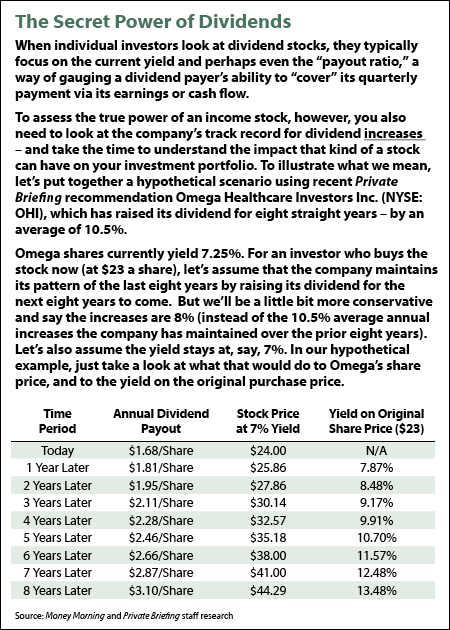Five Secrets You Must Know to Make Money in Stocks
Post on: 4 Июль, 2015 No Comment

- How To Enter At The Right Time
The right conditions exist when odds are favorable that prices are about to move in the desired direction AND that the move will be long enough to give you sufficient profits. At RightLine we call this the Setup.
The right time occurs when price begins to move in the direction you expected — AFTER the right conditions are met. This is called the Trigger.
— Entry Methods
Most entry methods are designed to take advantage of either established trends or trend reversals. For example, a pullback entry can be used to enter an established uptrend. The conditions for this Setup could be something like an uptrend sets a new 45-day high, followed by a decline to the 22 Day Moving Average, followed by a higher close the next day.
The Trigger could be a 0.50 point move above the higher close of the previous day.
Take a look at this example of a Setup that we call the Bullish Bounce.
Notice that this Bullish Bounce Setup locates a pullback in an established uptrend, and then waits for that pullback to show an early sign of resuming the uptrend. The Trigger is a specific entry point based on confirmation that the expected move is actually underway.
There are many entry methods you can use. Regardless of which techniques you choose, each one should include these two important components — Setups and Triggers.
Setups can be based on a wide range of criteria. Price action, volume data, volatility, financial performance, technical indicators, news events, management information, and seasonal traits – any one or a combination can be used depending on your preference.
Triggers are based on essentially one thing — confirmation that price is indeed beginning to move in the expected direction. Every entry method should always include a Setup and a Trigger.
— Time For a Surprise.
While stock picking and entry methods tend to get a lot of attention, the more important aspects of successful trading and investing are usually overlooked.
This is where the rubber meets the road. While every one of The Five Things You Must Know To Make Money In Stocks is important, some aspects are more important than others. In fact, the subject we’re about to get into is right up near the top.
- How To Exit At The Right Time
Exits are extremely important. Although most traders give the enter side of the trading equation a high priority, the exit side is often neglected. Failure to give exits the attention they deserve is one of the main reasons most individuals lose money in stocks.
Traders often watch their positions go up, then slide all the way back down. It’s easy to forget that paper profits only become real when they are converted to cash. Profitable exit strategies require active management, and deserve much more attention than entries.
— Human Instincts vs. Market Success
Studies show that when it comes to trading and investing, most folks just aren’t wired for it. While the instinctive fight or flight type of responses in every human serves an important purpose, our common instincts don’t work very well in the capital markets. People tend to make decisions emotionally. Unfortunately this quite normal approach to life experiences becomes self-destructive when applied to stocks.
Most investors sell their winning positions to make up for losers. Then they hold the losers way too long in hopes they will recover. This is the opposite of what should be done. Winners tend to keep on winning, while losers usually keep losing. The best approach is pretty simple: Get rid of losers promptly, and keep winners profitable with a clearly defined Exit Strategy.
— Planning Your Exit Strategy
There are three things that an effective exit strategy must do:
1) Minimize any initial losses
2) Maximize your initial profits
3) Minimize the amount of profit you give back
While there are dozens of different ways to accomplish these three objectives, basic concepts usually work best.
Although Exits plans can be built on a wide range of conditions, it all comes down to one specific number — the Exit Price. Since price action comes from the combined decisions of all buyers or sellers in a particular stock, we’ll use price action as an example of how to accomplish these three goals.
1) Minimize Your Initial Losses — Deciding where to set the initial Exit Price can be a challenge. On the one hand you need to allow enough room for normal daily price fluctuations, yet not so much room that your losses hurt deeply if the trade goes against you early.
One simple way to arrive at this is to use the stock’s ATR — Average True Range – for one bar of your chosen time frame. Once you know the amount of price movement that can reasonably be expected to occur, you can set your Exit Price beyond the ATR by a calculated amount.

This prevents normal price action from kicking you out of a trade, while a strong move against your position — and into your Exit Price — takes you out of danger before serious damage can occur.
Your initial Exit Price is also called a Stop, because it stops negative price action from injuring your trading capital.
2) Maximize Your Initial Profits — As price begins to move in your expected direction, the trade becomes less vulnerable to any negatives.
Price momentum then starts to influence the trade positively.
Since you want to secure any profits as soon as possible, move your Exit Price – your Stop — in the same direction as the positive price move, by exactly the same amount as the move itself. For instance, if price moves favorably by $1.25, move your Exit Price in the same direction by $1.25. As you may know, this procedure is called trailing a Stop.
Continue to move the Exit Price – the Trailing Stop — in the direction of the winning trade. You’ll do this on a regular basis, which is related to your chosen time frame. Intra-day traders using 30-minute bars would do this every half-hour. Daily traders would move their Trailing Stops once a day — usually after the normal market session ends. Longer time frames require less frequent adjustments.
3) Minimize The Amount Of Profit You Give Back — One way to accomplish this is to add an element to your Exit Strategy that reduces the amount you are willing to risk once you reach a certain amount of profit.
You can do this by setting a profit goal. Once that goal is reached, move your Trailing Stop 25% to 50% closer to the current price than your normal trailing amount. Although this increases the likelihood that the Stop will be triggered, it allows for sudden positive moves while limiting the amount of profit you ultimately give back.
Below is a chart example of an Exit Strategy. It may appear a bit busy at first glance, so just follow the red numbers. You will quickly understand how it works.
This Exit Strategy example uses price action as measured by the Average True Range. You can develop exit plans based on other concepts too. For instance, you might use a specific profit target taken at certain percentage of gains, or changes in volatility — the list of possible Exit methods is long.
Placing Stops on all positions forces traders to plan ahead. This means deciding in advance exactly the amount of loss to take if the trade doesn’t turn out as intended.
As mentioned earlier, most traders spend the majority of their time focusing on when to get in. However, at least twice as much attention should be placed on when to get out.
Here’s a simple reminder. Always know when to get out before you get in.
Make it easy on yourself. Get Buy & Sell instructions with specific Entry & Exit strategies for over 40 stocks a month in The RightLine Report!














